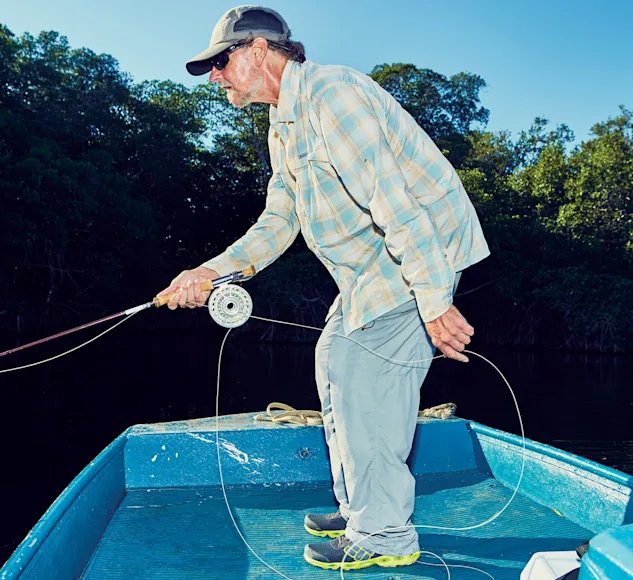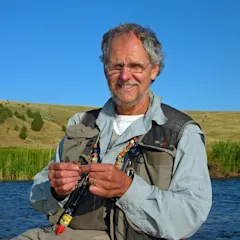A decades-long travel ban to Cuba has kept American anglers from experiencing some of the best flats fishing in the world. To see what we’ve been missing, the author and his friend spent a week in the country last year. They partied in Havana. They toured Hemingway’s home. And they chased bonefish, tarpon, and permit in an unspoiled tropical wilderness
“Bonefish. Ten o’clock.” Filipe’s voice is quiet, assured.
“I don’t see them,” I say.
“Just relax your eyes.”
I sweep the flat for shadows—bonefish often crystallize into perfectly observed fish only after you have blown the cast—but see only a few out-of-place reeds sticking above the surface. Almost as soon as I realize that these are feeding bonefish, their tails slicing and circling like hockey players, the tails drop from sight. No, there’s one, casting a shadow against the bottom. When my fly falls, the tail comes up as the head goes down.
“He’s got it,” Filipe says.
The bonefish races away. The line lifts a sheet of water and it’s gone, the guides making a high-pitched whining noise from the friction as the backing peels away, and time is like a wheel that has stopped turning. This is my third day fishing these mangrove flats, and what number bonefish this is I have no idea. Forty? Fifty? For the Las Salinas flats are arguably the finest in the world (being inside a bird sanctuary where outboards are prohibited, they are certainly the most serene), and you would think by now that I’d be accustomed to the singing of the reel. But the cast is never easy and the take never grows old, and only after the fish has tangled the line in the mangroves, comes free, tires, circles, comes to hand, and is admired and released do the gears reengage, and the day comes back to speed. Mother-of-pearl fish flash under the boat. A barracuda shows his malevolent grin. Two roseate spoonbills make stamps of pink against the green of a mangrove tree. Sun, clouds, water, silence.
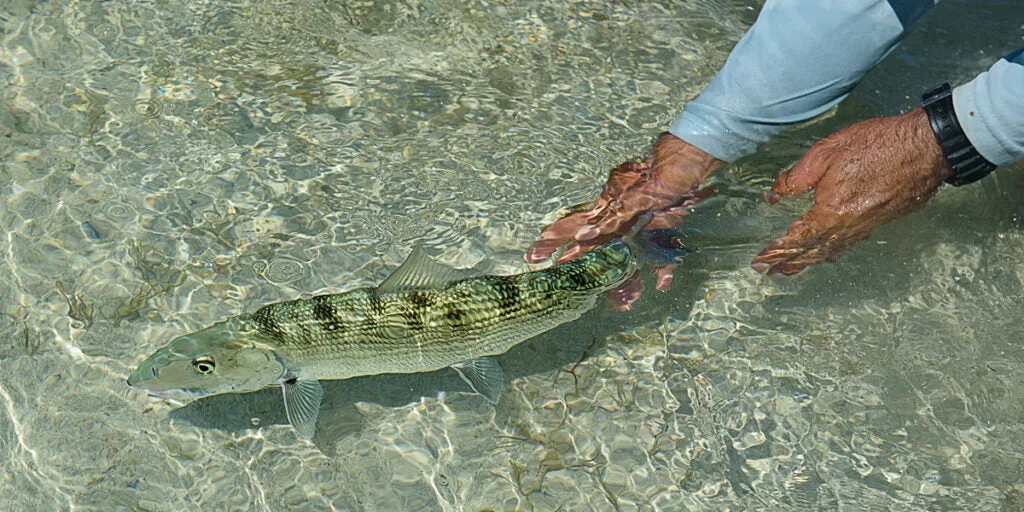
Releasing a nice bonefish. Ian Allen
Bringing time to a stop is why I am fishing in Cuba, a country that has been frozen in amber since the revolution’s end in 1959. The trip was a plan hatched with my good friend Steve Dunn before a campfire. I recalled a line Ernest Hemingway is said to have uttered when accused by Castro’s henchmen of siding with Batista loyalists. “The only plotting I am guilty of,” he said, “is plotting with a whiskey bottle.”
True, there was a difference. Steve and I were drinking our bourbon at a campsite on Montana’s Rock Creek, whereas Hemingway was speaking from the Finca Vigía, his home outside Havana. And whereas he would shortly be trying to get out of Cuba, we were plotting to get in—to see and fish this country before the embargo lifts and the high rises go up, the fleets of classic automobiles are lost to collectors, and the inshore fishing becomes fishing like anywhere else monied anglers exercise their passion—the mother ship, the Wi-Fi hookup, the fisherman hustled between flats on a modern bonefish skiff, seeing no more of the country or its people than he would by staying in the States.
Our quest to see and fish the real Cuba would involve a lot of research and no little hassle of chasing down the necessary documentation (it will be a snap of the fingers once the travel restrictions are fully lifted) and raises the obvious question.
Why?
Why fish Cuba when you can find productive flats fishing in other places where your legal status is assured? Hemingway would have told you it is the people. That is where you begin.
In Good Hands
Filipe Rodriguez Alonso is a compactly built, muscular man whose face remains remarkably unlined by the tropical sun, but his hands betray his vocation. The hands are spotted and gnarled from a quarter century of guiding anglers on the shoals that wash against the Zapata Peninsula, and even when Filipe is not fishing they seem to be wrapped around an invisible pole. Though Filipe does not suffer from the arthritis that afflicts many other fishermen, he worries about skin cancer and wonders what will give out first, the hands—he turns them over so I can witness the heavy spotting—or his opportunity to use them.
Along with two friends, who are his fellow guides and business partners—Lázaro Cotayo Cedeño, a fisheries biologist who used to run the crocodile reserve in Ciénaga de Zapata National Park, and Lázaro Viñola, whose house on the Bay of Pigs is where we are renting rooms—Filipe is acutely aware of the pressures that bear on the ecosystem here and that threaten his way of life. Ciénaga de Zapata comprises the largest intact wetlands in the Antilles. Wingbeats, the songs of some 250 bird species, and the echolike rumblings of crocodiles are its soundtrack. But the part of the park where we are fishing has drawn the attention of a foreign business concern that already monopolizes 90 percent of Cuba’s inshore fishing. If Las Salinas falls under the umbrella of its operations, which many here think is inevitable—money buying influence and Cuba being Cuba—the changes would probably be irreversible. Restrictions would be relaxed, and the flats dredged for a channel to accommodate outboard propellers. The dawn silence would be split by the roar of skiffs up on plane. The pink flamingos that stalk long-legged among the mangroves would fly somewhere else.
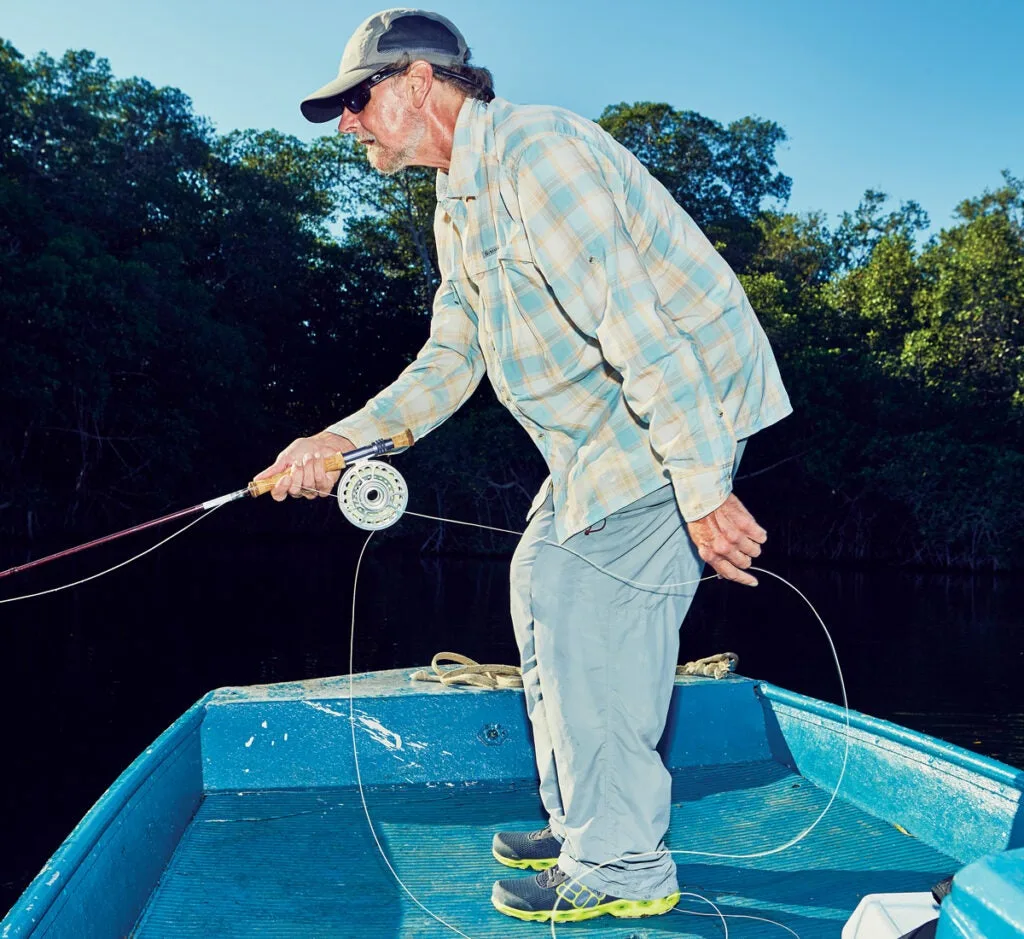
Hooking a tarpon makes you wonder if you should have cast in the first place. Ian Allen
Whether Filipe and his friends would fly with them or stay through the changes, he doesn’t know. He may be the best-known bonefish guide in Cuba, but he is in his 50s now and the writing is on the water.
But that is tomorrow, and today Filipe’s strong hands have poled the punt many miles from the flat-roofed, two-story building that serves as Ciénaga de Zapata headquarters. “We are out very far, but we are here now and I don’t care,” he tells me. Having borne the weight of a grave chronic illness in his family for decades, he explains that his only respite is on the water. It is a sentiment that any fisherman can understand, and as we glide toward the deeper basins in search of permit, I find that I have become much more invested in Filipe’s future, and in the future of his friends and his country, than I am in making the perfect cast if and when that long black lobe of the permit’s tail waves above the surface of the water.
It is by this measure that I know Steve and I have made the right decision to come to Cuba—to step through the porthole to see the country before it is changed forever, and to meet its people who anticipate that future with measures of both hope and trepidation.
Brave New World
Havana was our first stop, as it should be for anyone who visits Cuba. This gorgeous ruin, which has survived plagues, pirates, and revolution, not to mention the Seven Years War, has been crumbling around the feet of its citizenry since the first buildings were erected in the 16th century. Today a trip through Old Town is a trip back through time, best seen on foot and second best through the window of a classic American car. The capital’s construct is a hodgepodge of European and New World architecture. Some of the columns facing the courtyards of old hotels are as cracked as the faces of Cuba’s octogenarians, and when you are ascending the winding staircase to Paladar La Guarida, one of Havana’s best restaurants, passing bottom floors that look like something you’d see after the bombing of Beirut, you can be excused for holding your breath. At times, it seems the entire city is held together by steel cables, pastel paint, and what looks like a few thousand miles of piano wire.
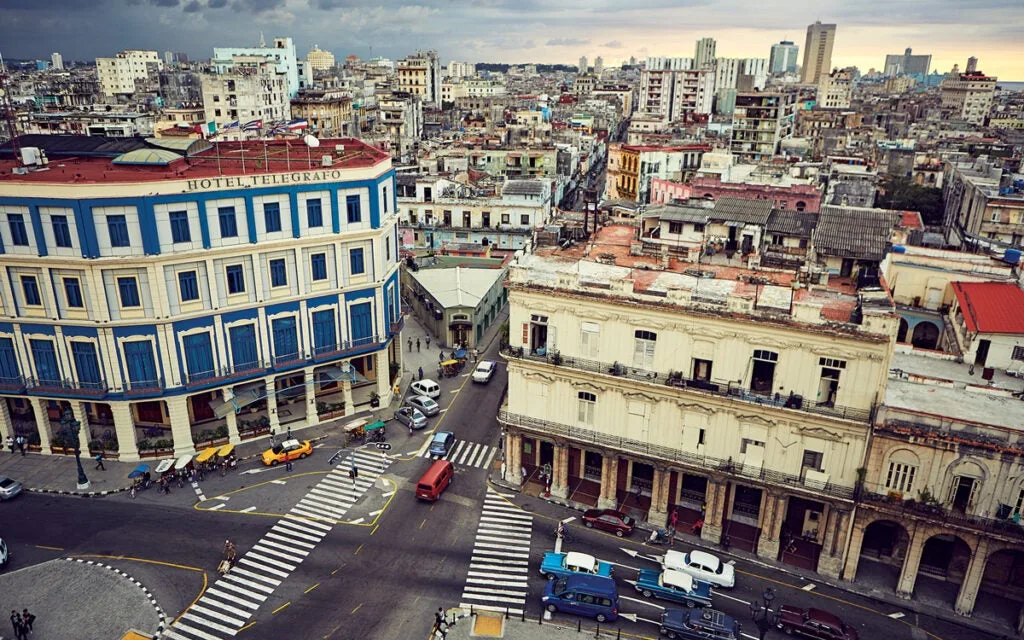
A view of old Havana from up high. Ian Allen
An octopus-head appetizer washed down with Selección de Maestros 10-year-old rum, followed by eggplant caviar and a main course of sweet plantain and a leg of lamb big enough to satisfy a pack of wild dogs, sets an optimistic mood for the rest of the evening’s activities. This commences with a wrong turn out the door and then a long walk to the Café Taberna, directed by well-intentioned fingers, not all pointing the same direction. But we find it as you do most places in Havana, eventually and in good time, and without any help from signs because there aren’t any. Cuba’s oldest café, as much dance club as dining establishment, has tall ceilings, an ebony bar, red tablecloths, and brown-and-white checkerboard tiles. The excellent in-house mambo band pays tribute to “top son” singer Benny Moré. A dancer dressed to kill snakes her way between tables to take Steve’s hand and drags him to the dance floor. Later she takes mine. Like the signature daiquiris, this is all part of the package.
After hours, Steve and I take a pink-and-white Chevy Bel Air to a club to listen to an Afro-Cuban jazz band, which is much less touristy. A Castro lookalike in green fatigues nods at the ceiling through a gauze of cigar smoke, the band is very hot and cool, and the three young women sitting at the next table throw their heads back and smoke theatrically, holding cigarettes between their first two fingers, like sirens of the silver screen. One is black, one brown, one white, and taken collectively they are the most beautiful three women I have ever seen, until, an hour later, their table is taken by three others. One smiles at me encouragingly. I don’t need the guidebook to tell me that she is a jinetera, Cuban slang for “street jockey,” a female sex worker. A word about that.
While it is great fun to whirl around the floor of a Cuban club with a professional dancer, it is quite another matter to make so much as eye contact with a jinetera, who will trade sex for money, or maybe just dinner and a good time, though it will cost you all the same, because the next day there will be a brother who needs money for an operation or some other request. What she’s ultimately looking for is a ticket out of the country that gave her a college degree but nothing profitable to do with it, which is why she’s trying to catch your eye. Jineteras are as personable as they are stunning, but their hallmark characteristic is persistence. Once they have your attention, they are very hard to say no to. So say no. Better yet: Don’t let it reach the point where you have to.
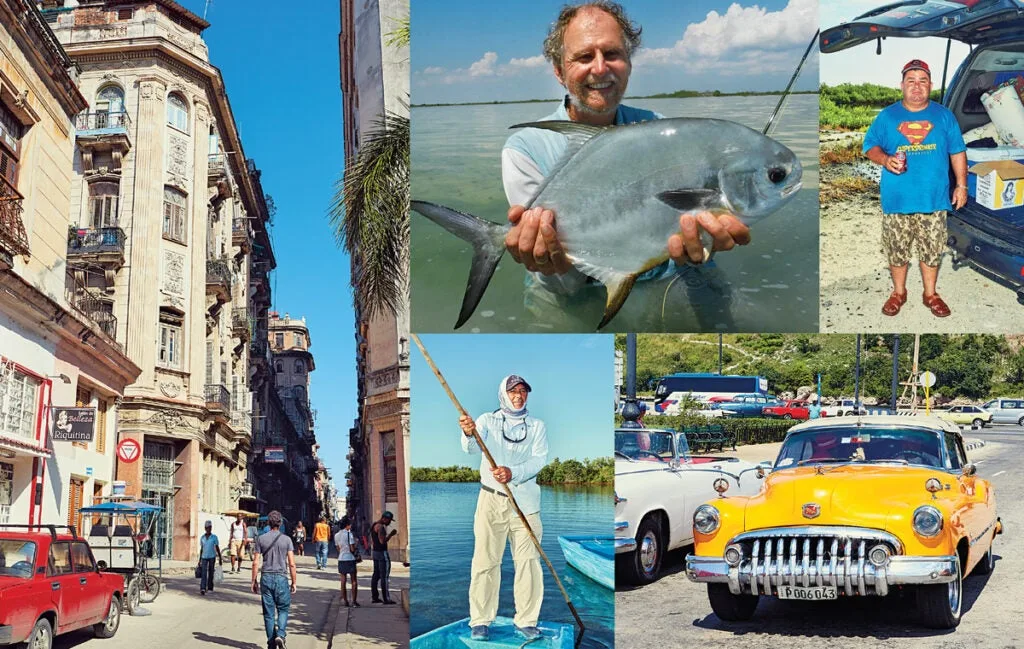
F&S Ian Allen
This caution applies equally to female tourists. While Steve and I were waiting in line to go through customs at José Martí International Airport in Havana, three English women with spiky hair struck up a conversation with us. Steve asked where they were from and the ringleader, who had pink streaks in a blonde crew cut, said Dorset. “The question isn’t where we’re from, luv,” she added, smiling at us. “It’s what are we doing ’ere?” She and her friends laughed hysterically.
Two days later we saw the same woman sitting on a green park bench in Old Havana’s Parque del Cristo with her head hanging down and her mascara streaked, openly crying. A Cuban boy wearing no shoes and no shirt and who was perhaps all of 15 sat with his arm around her. There was a story there. It didn’t look like a happy one. Steve took it as a sign. “It’s time to go fishing,” he said.
Kings of the River
Among the fraternity of flats fishermen, the bonefish is called the Oh, wow! fish. It is the species that makes you marvel at its speed and is a pure rush to hook. By contrast, the tarpon is the Holy s–t! fish. Hooking one makes you wonder if you should have made the cast in the first place, but now that you have one on, you wish you had a bigger rod.
We’re targeting tarpon in the Río Hatiguanico, which drains Zapata Park only a few dozen miles from the Las Salinas flats. It is the change-of-pace day that our guides worked into the middle of the trip, though change of pace is a mild way of putting it. I have been on the casting platform of more than one boat looking up at 6 feet of silvered muscle coming down, and then, moments after the tarpon has crashed back to the surface, seen the fish so far away that, jumping, it looked like a MirrOlure imprinted against the mangroves. But on the shoals and in the basins where you normally encounter tarpon, the only part of your body that you have to worry about giving out is your heart. That isn’t so when you’re tarpon fishing the Río Hatiguanico.
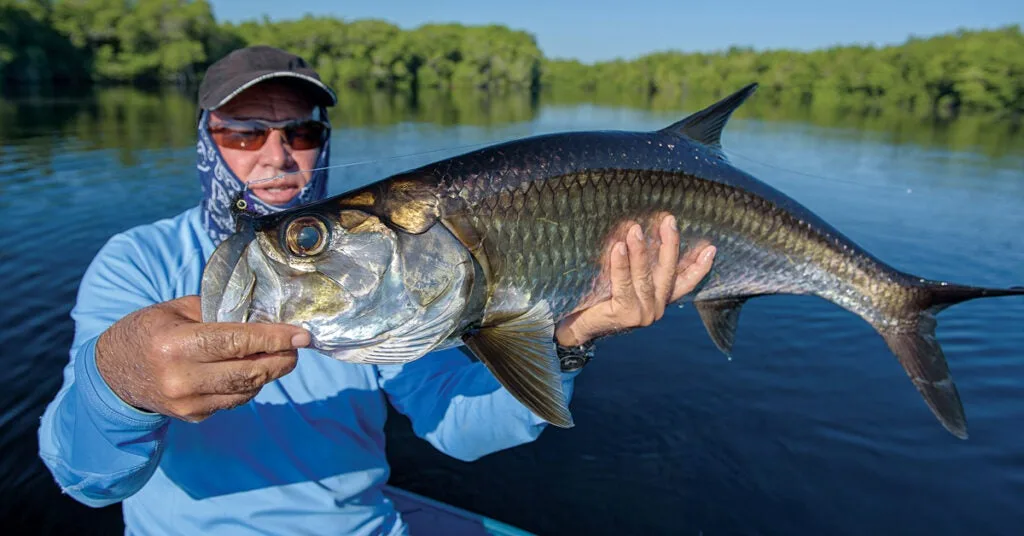
A tarpon from the Rio Hatiguanico. Ian Allen
This brackish mangrove river, fed by arteries of current so narrow in places that the limbs meet overhead, has a jungle feel to it reminiscent of the Everglades. It is a place of oppressive heat, with a full contingent of reptiles with forked tongues and toothy smiles. The river’s tarpon are the strangest-behaving tarpon I have ever fished for. Typically, tarpon are the spookiest of all inshore fish. A false cast that throws a wisp of shadow, a fly crossing the fish’s mouth at the wrong angle, or the distant hum of an outboard motor—all are enough to make a tarpon vanish. But these fish, 10- to 30-pounders that run in schools like gangs of teenage hoodlums, seem energized by commotion.
On this day I fished with Viñola, our host, who is one of the shyest and sweetest men I have ever met, but whose fishing strategy was to run over a school with the outboard, then cut the motor and cast as we drifted back over them. You knew they were there because the fish would begin thrashing at the surface, some out in the current, others deep under the mangroves. It was as if they took our intrusion as a personal affront. This was spooky fishing, made more so by the tackle we were using.
Typically, you tie a foot or more of 20-pound fluorocarbon just in back of the heavier bite tippet to ensure that your leader breaks before your backing does and you don’t lose your fly line. But Steve and I were told to run straight 80-pound with the idea of really leaning on the tarpon and keeping them from tangling in the mangrove roots. When there’s no weak spot in your equipment, however, bad things happen: Rods break, for starters, and if a turn of fly line wraps around a finger or any other part of your anatomy? Well, something’s going to give, and it isn’t the 80-pound line—and it sure as hell isn’t the tarpon.
“No te pongas a mear por el lado del barco cuando alguien engancha un sábalo,” one of the guides jokes when we pull the boats together for lunch. Translation: Don’t pee over the side when someone hooks a tarpon.
We all laugh—Steve and I a little uneasily—but we have been laughing with Lázaro, Viñola, and Filipe for four days now. Laughter, the universal language, is as necessary as breath and as common as birdsong in Cuba, and more than the sights, more than the fishing, that laughter and the camaraderie are what you remember most about this place and its people.
The river is stained a dark tea color by the tannins, and the first tarpon I hook flashes from the depths like a tangerine minnow, if tangerine minnows ran to 30 pounds and rattled their gill covers when they jumped. The fish dives under the boat and jumps higher than the level of my head on the opposite side as I drag the rod tip around the bow with the tip under the water to keep it from bending double and breaking. Then the fish leaps against the mangroves on the other side of the river from where the rod is now pointing. Tiring, it winks up from the depths like a gold coin and finally breaks the surface, turning to silver with the kiss of the sun. It is miner’s work, catching these tarpon, and between the two of us, we hook eight and land four. By day’s end our arms are sore and we are drenched in sweat, but we leave the river with all our necessary appendages intact.
Heart & Soul
The subject of broken rods comes up as Filipe poles the boat for permit during the final hours of our last day of fishing. He begins by telling me about meeting Lefty Kreh, whom he guided a few years ago. “Many wanted to fish with him,” Filipe tells me. “But Lefty said, ‘I am a simple fisherman. I want to fish with simple Cuban fisherman and live with Cuban people.’ He chose to fish with me. He gave me rods with his name on them. I am very honored.”
Kreh’s rods, along with pieces of others broken by tarpon in the Río Hatiguanico, are the tools with which Filipe teaches children in his village how to cast. Like coats of many colors, these patched-together rods are regarded with pride, and some of the boys are among the best fly casters Filipe has ever seen. His hope is that a few of the boys will be the guides of the next generation. But in Cuba, sportfishing is a commercial venture, restricted to paying clients, and with rare exceptions the closest to flyfishing that most locals will ever get is casting a piece of yarn in an acre of scrubby grass.
Another reminder that Cuba remains far from a democracy is harbingered by the clouds building over the open ocean on the horizon. Like many Cubans, Filipe has known people who have sought their freedom in the currents off the coast. Several boys of his acquaintance, he tells me, were among those not so fortunate. He heard they hired Mexican smugglers to boat them to Florida, but they were never heard from again. It was assumed that the smugglers simply murdered them, emptied their pockets, and dropped the bodies overboard. Less risk that way, and better reward.
Filipe shrugs his shoulders. His dark eyes are bright. What can you do?
There is nothing to say to that but I’m sorry. For a while there is the regular push of the pole against the bottom, the spaced puffs of the disturbed marl, and nothing else.
Filipe breaks the silence: “You asked me how I became a fisherman, but we were interrupted by the bonefish.”
“Yes, those damned bonefish,” I reply. “We can’t seem to get away from them.”
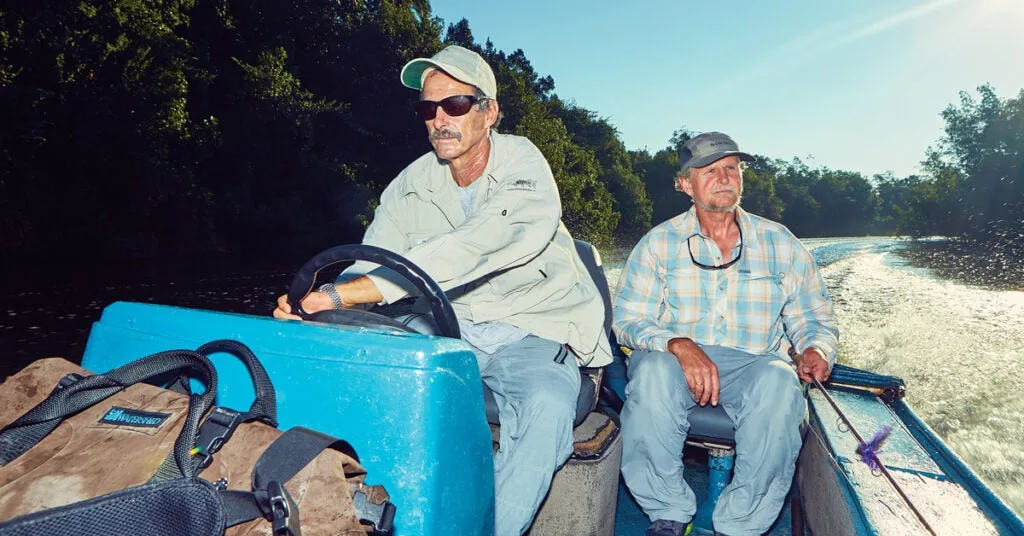
F&S Ian Allen
Filipe’s smile stretches his clinging sun mask. He has already told me about handline fishing for the table with a Cuban yo-yo as a boy, but now he begins to fill in the pages of his life story. Born to a revolutionary father and a mother who just wanted to see her son return to her alive, he left the innocence of fishing behind to join the army and as a teen fought in the Popular Movement for the Liberation of Angola. “My father told me it was the honorable thing to do,” he says, “to free the black man from his oppressors.”
Returning from Africa with recurring headaches, courtesy of the concussive blasts of warfare, he earned his master’s degree and began a high school teaching career. He taught Marxist philosophy at first, then other philosophies, as well as languages. (Filipe, like many Cubans, is fluent in several languages besides Spanish and English.) Fishing fell off the radar as he became involved in schools and in various children’s programs—one of which landed him in prison when his boss was accused of handing out more food rations than the government program stipulated, or perhaps not distributing the food as he claimed, but selling it for profit, and Filipe was caught in the net. Released after a year’s incarceration, and with his youthful idealism shattered, he found that his record made him virtually unemployable. He finally got a job bartending at a famous largemouth bass lake, where he spent his free time fishing so that he might take advantage if a guiding position opened up. This was in the days when anglers whittled lures and dissolved plastic shoes in mosquito repellent to mold into plastic worms. When Filipe finally got his chance to guide, he became the most skilled angler on the lake.
Although he had lived most of his life in the village of Jagüey Grande, only 15 miles from Las Salinas, it never occurred to Filipe that someone would pay to fish for bonefish, as you couldn’t eat them and they were without mystery—as common as the flamingos and the ever present schools of mojarra. When flats fishing became popular, and the opportunity to guide in what amounted to his own backyard arose, Filipe put down the oars and picked up the pushpole and found his true vocation, and in its setting his church, something that he struggles to put into words.
“This is my heart,” he says, clutching at his chest as I turn to face him from the bow. “This is my soul,” he says. His hand moves away from his chest to encompass the flat before reaching toward the heavens.
Old Men and La Mar
It is impossible to plan a fishing trip to Cuba without a nod to Ernest Hemingway, whose soul also belonged to Cuba. Steve and I did better than a nod, thanks to friends in the Hemingway family, and were afforded the privilege of a private tour of Finca Vigía, the beautiful Spanish colonial home outside Havana that Hemingway bought with his third wife, Martha Gellhorn, in 1940.
It was here, in a spare bedroom with a leopard skin draped over an armoire and with his slippered feet planted on the worn skin of a lesser kudu, that Hemingway wrote The Old Man and the Sea. Suffering back pain from injuries incurred in a plane crash in Africa, he worked standing up, writing in pencil on unlined onionskin paper that he placed on a small reading board perched on one of several bookshelves, securing the written pages under a chunk of copper ore from the breezes that came through the east-facing windows.
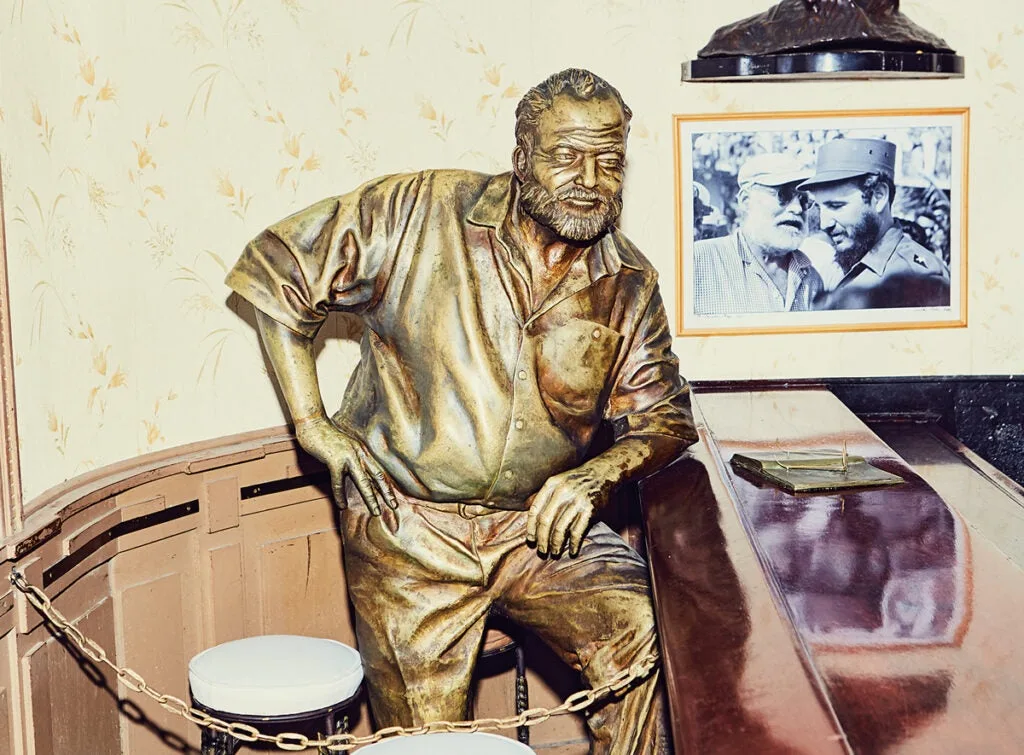
F&S Ian Allen
At its simplest, The Old Man and the Sea tells the story of an old fisherman, Santiago, who has fallen on hard luck and has gone 84 days without a fish, but who finally catches a great marlin, only to have it destroyed by sharks before he can tow it back to shore. The story can be read on many levels and contrasts the two kinds of fishermen who plied the waters off the northern coast of Cuba at the time. There were those like Santiago, who were part of a culture that relied on experience and faith, rather than upon modern technology, and who were bound to family and tightly knit communities. To these fishermen the sea was la mar, in the Spanish feminine, loved even as she was respected and feared. The younger, more modern fishermen, who were not so closely tied to the local community, relied on boat motors instead of oars, and used buoys instead of simple handlines to fish. They spoke of the sea as el mar, in the masculine, considering him a rival or even an enemy.
I had packed a copy of the novella with my fishing gear and finished it the night before Filipe and I went in search of permit in the outer basins. It was hard not to draw the comparison between the old man, with his traditional ways and love of the sea, and Filipe and our other two guides. Although unrelated by blood, they considered one another family and fished in the old manner, in simple wooden craft, with little dependence upon outboard motors, and with GPS in their heads rather than mounted on a console. These sons of Santiago, as I would come to think of them, were, like the old fisherman himself, among the last of their kind, and if their small corner of la mar is, in fact, bought out by foreign interests, Cuba will be the poorer.
Full Circle
Inside the necklace of mangroves, the basin is like a tranquil pearl, protected from the open ocean whose curling white lips can be seen at the horizon. Filipe points out holes where the marl looks cloudy and says they were made by permit rooting for crabs. I trade the 8-weight for the 10 and we test the sink rate of several crab patterns before settling on one. The idea is that you cast the fly a short distance in front of the fish (not a long lead like you give bonefish, because you want the permit to hear the fly land), count it down, and then strip slowly. That is the idea. But if the bonefish is the Oh, wow! and tarpon the Holy s - - t!, the permit is the It’s a miracle! fish. Because with permit things almost always go wrong, even if you do everything right.
The first fish looks like a shark at this distance, its dorsal fin and the tall black lobe of its tail cutting like a scythe across the surface of the basin. A big one. He’s coming. He’s coming. Filipe digs in the pole to turn the boat for the best shot and the cast is good, but the permit veers away. I know of no other fish that seems so afraid of its own food.
The afternoon grows long. With permit there usually is no next time, and I have already had two good shots. But then we spot more, a school of six or seven, practically under the boat. When the crab fly drops, they jockey for position and one follows, then another darts ahead of him. And like that the fish is on.
There is really nothing in the sea like a permit and no way to adequately describe its straight-line power except to say that the fish leaves you shaking. I jumped into the water when it began to circle and closed my hand on the wrist of its tail. Up close, the permit is nearly circular and as bright as a mirror. You can see your face in its side, who you are now and who you once were, when all fish were this wondrous.
Even Filipe, who has seen many permit, is visibly moved when the fish has gone.
“This my home,” he says to me, his eyes drift-ing around the basin. “I want to die in Cuba.”
We are so far out and it is so late now that, we will learn later, the others have climbed to the roof of the park headquarters to search for our boat with binoculars. “We can fish some more on the way back,” Filipe says. “We will see some bonefish, maybe another permit.” He shrugs. “Or we can just talk.”
I break down the rod—it is Filipe’s now. Then I pull off my sun gloves and hand them to him. Anything to keep this man in this place, while there is still sand in the hourglass. Filipe stretches them over his hands and flexes his fingers. And picks up the pole.
Summer Reading: Keith McCafferty is an award-winning novelist. His newest book, Buffalo Jump Blues, is now available.

